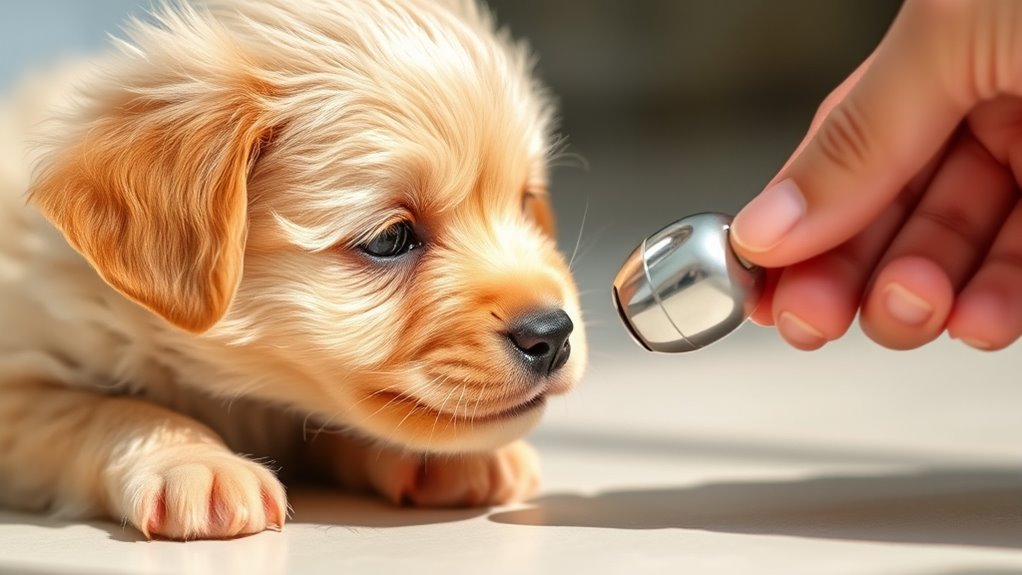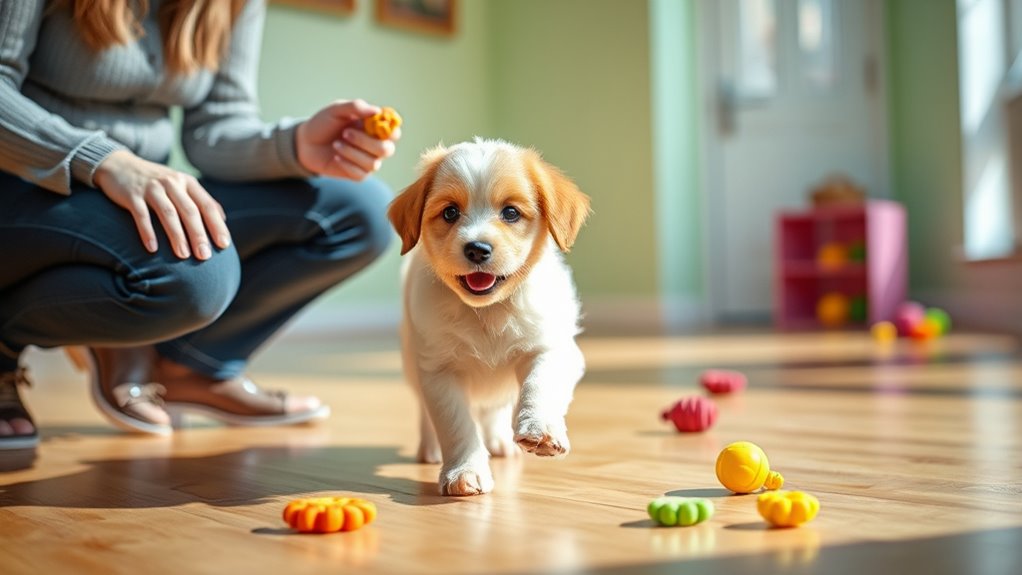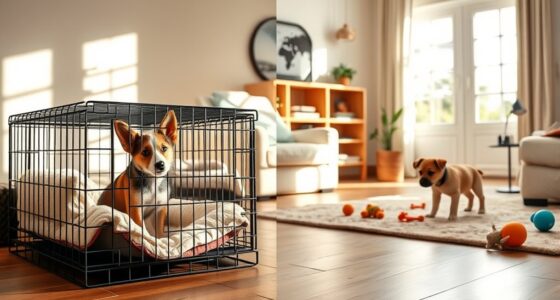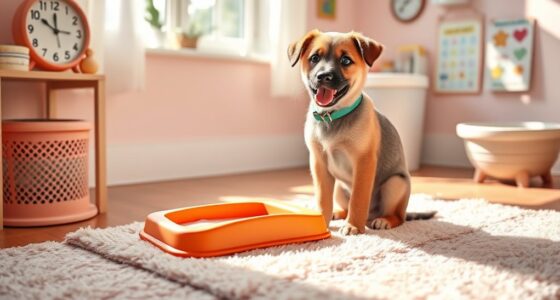To get started with clicker training, first pair the clicker with treats by clicking once and giving a treat repeatedly until your puppy associates the sound with rewards. Keep training sessions short, and always click exactly when your puppy performs the desired behavior, like sitting. Be consistent and patient, redirecting if needed. Once your puppy understands the cue, you’ll see more responsiveness and confidence. Continue exploring these techniques to build a strong bond and effective communication.
Key Takeaways
- Pair the clicker with treats to create a strong positive association before training begins.
- Use precise timing to click immediately when the puppy performs the desired behavior.
- Keep training sessions short, engaging, and consistent to maintain puppy attention and reinforce learning.
- Follow each click with a treat or praise to clearly mark the correct behavior.
- Be patient and celebrate small successes to build confidence and strengthen your bond with your puppy.

Clicker training is a highly effective method for teaching puppies good behavior and commands, making the learning process fun and positive for both of you. At its core, it relies on positive reinforcement, which means rewarding your puppy immediately after they perform a desired action. This helps your puppy understand exactly what behavior earns a treat or praise, encouraging them to repeat it. The key to success with clicker training is mastering timing techniques. You need to click the moment your puppy does something right—no delay—to create a clear association between the behavior and the positive reward.
Clicker training uses positive reinforcement and perfect timing to teach puppies good behavior effectively.
When starting out, you’ll want to introduce your puppy to the clicker by pairing it with treats. Click once, then give your puppy a treat right afterward. Repeat this several times until your puppy begins to associate the click with something good. Once they understand that the click signals a reward, you can start using it during training sessions. When your puppy performs a command or behavior you want to reinforce, click the instant they do it correctly. The quick, precise timing signals to your puppy that they’ve done something right, strengthening their understanding of the command.
Timing techniques are vital because they make or break the effectiveness of clicker training. If you click too early or too late, your puppy might get confused about which behavior earned the reward. For example, if you’re teaching “sit,” wait until your puppy’s bottom hits the ground before clicking and giving the treat. This precise timing helps your puppy connect the dots quickly. Practice makes perfect—your timing will improve as you gain more experience, making training more efficient.
Keep training sessions short and engaging to hold your puppy’s attention. Use the clicker consistently to mark behaviors, and always follow the click with a treat or praise. This consistency helps your puppy understand exactly what you expect. Remember to stay patient, as puppies are still learning how to communicate and respond. If your puppy gets distracted or makes mistakes, calmly redirect them back to the task and reward their success once they get it right.
As you progress, you’ll find that positive reinforcement and proper timing techniques create a strong foundation for future training. Your puppy will become more responsive, enthusiastic to please, and confident in their commands. The bond you develop through this method is built on trust and clear communication, making training sessions enjoyable rather than frustrating. Stick with it, be consistent, and celebrate small victories along the way. With patience and practice, clicker training will become an effective tool to help your puppy grow into a well-behaved, happy companion. Additionally, understanding essential oils for training can support your puppy’s overall well-being during the learning process.
Frequently Asked Questions
Can Clicker Training Work for Aggressive Puppies?
Yes, clicker training can work for aggressive puppies, but it requires patience and consistency. You should focus on puppy socialization to help reduce aggression and build positive behaviors. Training consistency is key—use the clicker to reinforce calm, friendly responses, and avoid rewarding aggressive actions. With gentle, structured training, you can help your puppy learn better behaviors and gradually decrease aggression, making your bond stronger and more positive.
How Do I Prevent My Puppy From Becoming Clicker-Dependent?
To prevent your puppy from becoming clicker-dependent, foster freedom through consistent independence training. Gradually reduce clicker reliance by pairing it with natural rewards and slowly phasing out its use during training sessions. Practice patience, promote perseverance, and provide plenty of praise outside of clicker cues. This approach encourages your puppy to develop confidence and independence, ensuring they don’t rely solely on the clicker but instead learn to respond reliably on their own.
Is Clicker Training Suitable for Puppies With Special Needs?
Yes, clicker training suits puppies with special needs when you adapt your approach with positive reinforcement and sensory considerations. You can modify the clicker’s sounds, use visual cues, or gentle rewards to accommodate sensory sensitivities. This method promotes learning without overwhelming your puppy, helping them thrive. By tailoring your training, you foster a positive, supportive environment that encourages your puppy’s development and confidence, regardless of their unique needs.
What Should I Do if My Puppy Is Afraid of the Clicker?
If your puppy is afraid of the clicker, try clicker desensitization to reduce fear gradually. Start by quietly introducing the clicker without expecting any response, then pair the sound with treats to build positive associations. Keep sessions short and gentle, allowing your puppy to become comfortable at their own pace. Over time, this approach promotes fear reduction and helps your puppy trust the clicker as a positive signal.
How Long Does It Typically Take to See Results?
You can usually see results within a few days to a week, but it depends on your timing consistency and reward timing. When you click and immediately reward your puppy, they quickly understand the connection. Stay patient and consistent, reinforcing good behavior with timely rewards. If you stick to this approach, you’ll notice progress faster, and your puppy will learn new commands more effectively.
Conclusion
So, now you’re a clicker connoisseur, ready to turn that tiny furball into a well-behaved superstar. Just remember, patience is key—because nothing says “good boy” like a click and a treat, even if your puppy’s more interested in chewing your shoes. Keep it fun, stay consistent, and soon enough, your pup will be the toast of the town. Who knew training could be this easy? Well, you did—after all, you’ve got the clicker!










